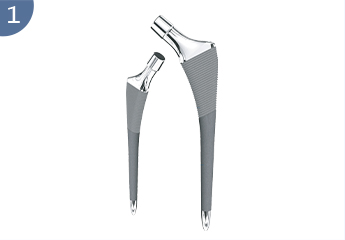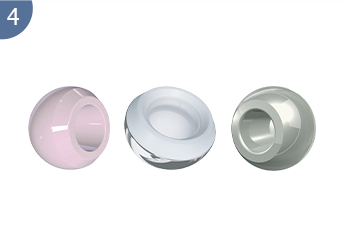Cementless Semi-Hip System: An Innovative Solution for Hip Replacement
Hip replacement is a common surgical procedure that involves replacing a damaged or diseased hip joint with an artificial one. Traditionally, cemented hip implants have been used for this purpose. However, in recent years, there has been a growing interest in cementless hip implants due to their potential benefits. In this article, we will explore the concept of a cementless semi-hip system, its advantages, and how it compares to traditional cemented hip implants.
Introduction
Hip replacement surgery is one of the most successful orthopedic surgeries performed today. It has a high success rate, with most patients experiencing significant pain relief and improved mobility. Traditional hip replacement surgery involves using cemented hip implants, which are held in place with bone cement. However, cemented hip implants have some disadvantages, including a higher risk of loosening over time and a potential risk of infection.
What is a Cementless Semi-Hip System?
A cementless semi-hip system is an innovative solution for hip replacement surgery. Unlike traditional cemented hip implants, cementless semi-hip systems do not rely on bone cement to hold the implant in place. Instead, they use a combination of special coatings and materials that allow the bone to grow into the implant, creating a more stable and long-lasting connection.
Advantages of Cementless Semi-Hip Systems
There are several advantages to using a cementless semi-hip system over a traditional cemented hip implant. These advantages include:
Longer Lifespan
Cementless semi-hip systems have a longer lifespan compared to traditional cemented hip implants. This is because they rely on natural bone growth to hold the implant in place, which creates a more stable and long-lasting connection.
Reduced Risk of Loosening
Cemented hip implants have a higher risk of loosening over time, which can lead to implant failure and the need for revision surgery. Cementless semi-hip systems have a reduced risk of loosening, which means that patients are less likely to require revision surgery in the future.
Better Biocompatibility
Cementless semi-hip systems are designed to be biocompatible with the body, which means that they are less likely to cause an adverse reaction or rejection by the immune system. This is particularly important for patients with allergies or sensitivities to certain materials.
Faster Recovery
Cementless semi-hip systems may offer a faster recovery time compared to traditional cemented hip implants. This is because the lack of bone cement allows for better bone growth and healing around the implant.
How Does a Cementless Semi-Hip System Compare to a Cemented Hip Implant?
There are several key differences between a cementless semi-hip system and a traditional cemented hip implant. These include:
Surgical Technique
The surgical technique used for a cementless semi-hip system is slightly different from that used for a cemented hip implant. This is because the implant must be inserted in a way that allows for natural bone growth and integration.
Materials
Cementless semi-hip systems use different materials and coatings compared to traditional cemented hip implants. These materials and coatings are designed to promote natural bone growth and integration.
Risk of Infection
Cemented hip implants have a potential risk of infection due to the use of bone cement. Cementless semi-hip systems have a reduced risk of infection due to the lack of bone cement.
Cost
Cementless semi-hip systems may be more expensive than traditional cemented hip implants. However, the potential benefits and longer lifespan may outweigh the initial cost.
Conclusion
Cementless semi-hip systems are an innovative solution for hip replacement surgery. They offer several advantages over traditional cemented hip implants, including a longer lifespan, reduced risk of loosening, better biocompatibility, and potentially faster recovery time. While there are some differences in surgical technique and materials used, the benefits of a cementless semi-hip system may outweigh the initial cost. Patients considering hip replacement surgery should discuss the pros and cons of different implant options with their doctor to determine which is the best option for their individual needs.
FAQs
1. What is a cementless semi-hip system?
A cementless semi-hip system is an innovative solution for hip replacement surgery that does not rely on bone cement to hold the implant in place.
2. How does a cementless semi-hip system differ from a traditional cemented hip implant?
Cementless semi-hip systems use special coatings and materials that allow the bone to grow into the implant, creating a more stable and long-lasting connection. Traditional cemented hip implants use bone cement to hold the implant in place.
3. What are the advantages of a cementless semi-hip system?
Advantages of a cementless semi-hip system include a longer lifespan, reduced risk of loosening, better biocompatibility, and potentially faster recovery time.
4. Is a cementless semi-hip system more expensive than a traditional cemented hip implant?
Cementless semi-hip systems may be more expensive than traditional cemented hip implants, but the potential benefits and longer lifespan may outweigh the initial cost.
5. Who is a good candidate for a cementless semi-hip system?
Patients considering hip replacement surgery should discuss the pros and cons of different implant options with their doctor to determine which is the best option for their individual needs. Factors such as age, health, and activity level may influence the choice of implant.
English
Français
Русский
Español
العربية
Português
Deutsch
italiano
日本語
한국어
Nederlands
Tiếng Việt
ไทย
Polski
Türkçe
አማርኛ
ພາສາລາວ
ភាសាខ្មែរ
Bahasa Melayu
ဗမာစာ
தமிழ்
Filipino
Bahasa Indonesia
magyar
Română
Čeština
Монгол
қазақ
Српски
हिन्दी
فارسی
Kiswahili
Slovenčina
Slovenščina
Norsk
Svenska
українська
Ελληνικά
Suomi
Հայերեն
עברית
Latine
Dansk
اردو
Shqip
বাংলা
Hrvatski
Afrikaans
Gaeilge
Eesti keel
Māori
नेपाली
Oʻzbekcha
latviešu
অসমীয়া
Aymara
Azərbaycan dili
Bamanankan
Euskara
Беларуская мова
भोजपुरी
Bosanski
Български
Català
Cebuano
Corsu
ދިވެހި
डोग्रिड ने दी
Esperanto
Eʋegbe
Frysk
Galego
ქართული
guarani
ગુજરાતી
Kreyòl ayisyen
Hausa
ʻŌlelo Hawaiʻi
Hmoob
íslenska
Igbo
Ilocano
Basa Jawa
ಕನ್ನಡ
Kinyarwanda
गोंगेन हें नांव
Krio we dɛn kɔl Krio
Kurdî
Kurdî
Кыргызча
Lingala
Lietuvių
Oluganda
Lëtzebuergesch
Македонски
मैथिली
Malagasy
മലയാളം
Malti
मराठी
ꯃꯦꯇꯥꯏ (ꯃꯅꯤꯄꯨꯔꯤ) ꯴.
Mizo tawng
Chichewa
ଓଡ଼ିଆ
Afaan Oromoo
پښتو
ਪੰਜਾਬੀ
Runasimi
Gagana Samoa
संस्कृत
Gaelo Albannach
Sepeti
Sesotho
chiShona
سنڌي
Soomaali
Basa Sunda
Wikang Tagalog
Тоҷикӣ
Татарча
తెలుగు
ትግንያውያን
Xitsonga
Türkmençe
संस्कृत
ئۇيغۇرچە
Cymraeg
isiXhosa
ייִדיש
Yorùbá
isiZulu










































